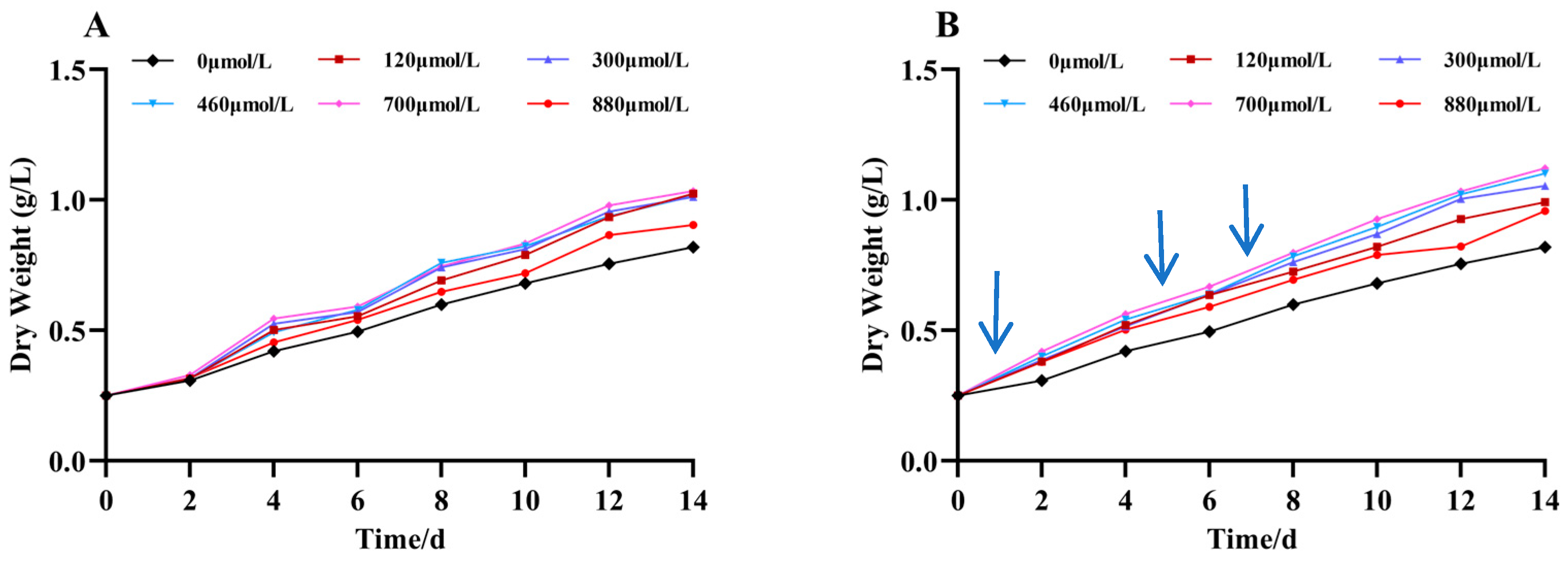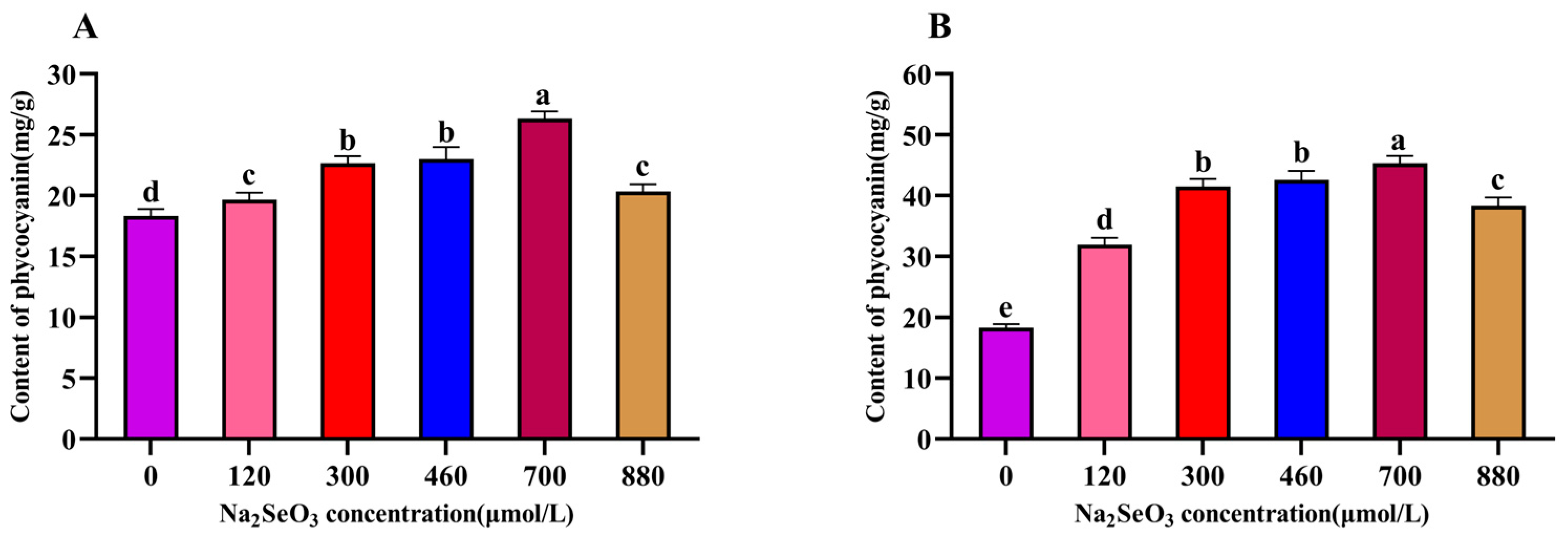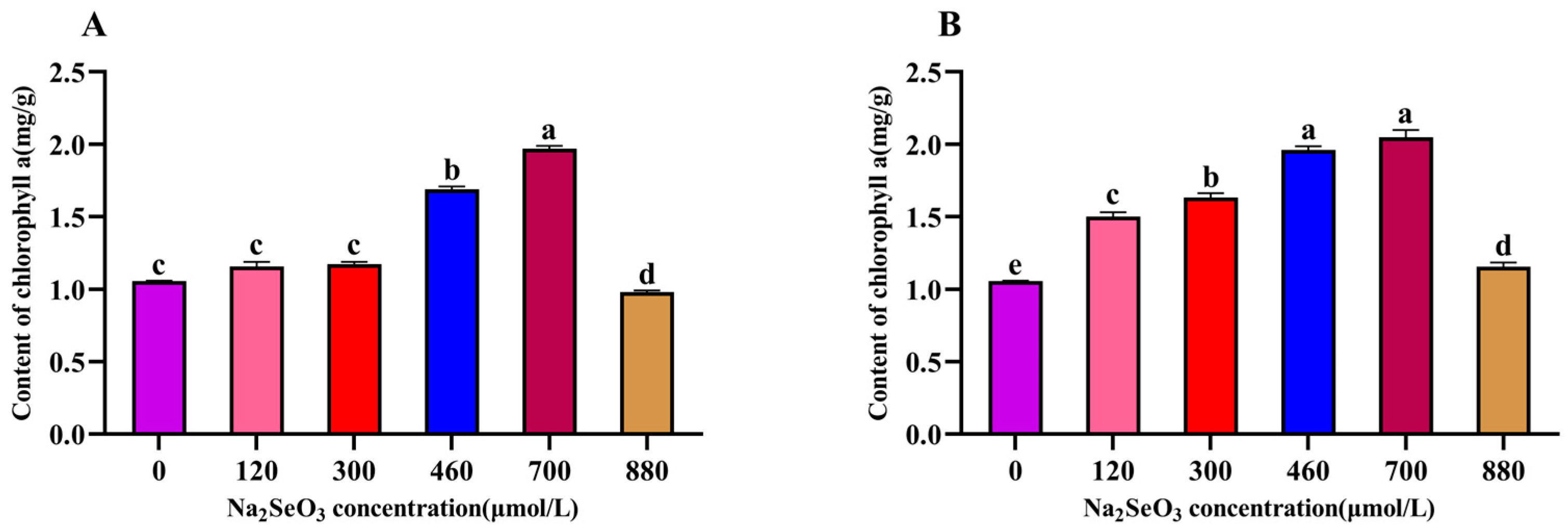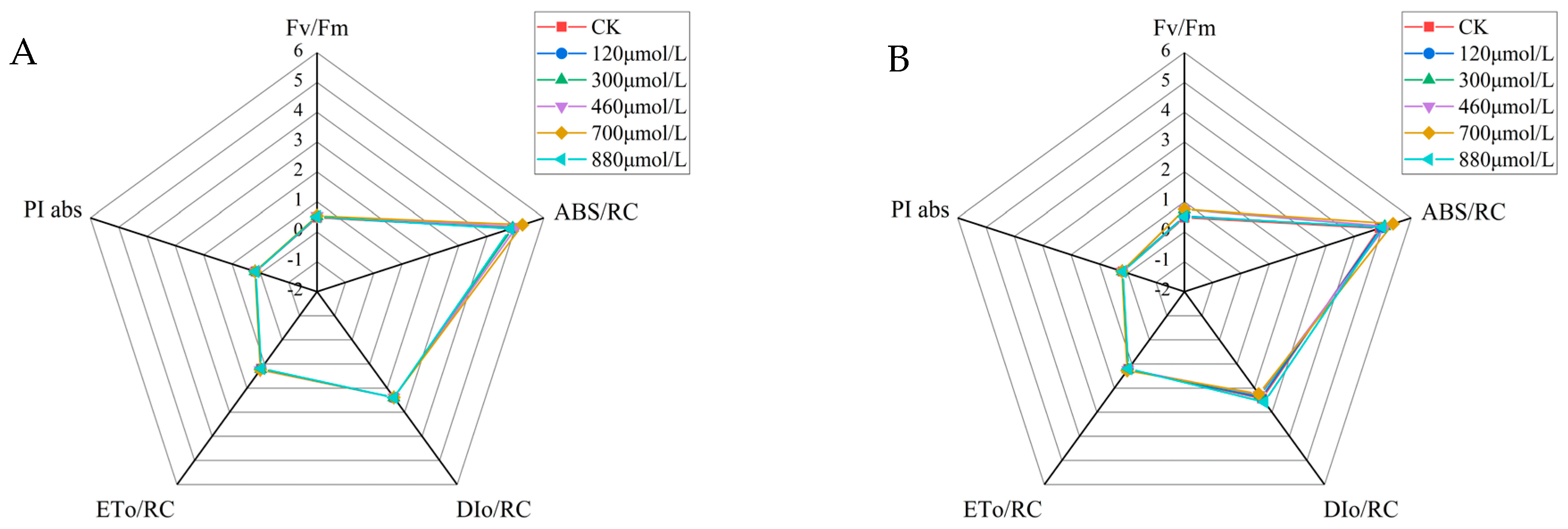Effects of Sodium Selenite on the Growth and Photosystem II Activity of Arthrospira platensis Gom.
Abstract
:1. Introduction
2. Materials and Methods
2.1. Experimental Materials
2.2. Experimental Method
2.2.1. A. platensis Culture
2.2.2. Sodium Selenite Treatment Concentrations
2.2.3. Sodium Selenite Addition Method
One-Time Addition
Additions in Batches
2.2.4. A. platensis Biomass Determination
2.2.5. Determination of the Soluble Protein and Phycocyanin C (C-PC) Contents of the A. platensis
2.2.6. Determination of Chlorophyll A Content in the A. platensis
2.2.7. Determination of the Antioxidant Enzyme Activity in the A. platensis
Determination of Superoxide Dismutase (SOD)
Measurement of Catalase (CAT)
Determination of Malondialdehyde (MDA)
2.2.8. Measurement of the Chlorophyll A Fluorescence Parameters
2.3. Data Processing
3. Results and Discussion
3.1. Effect of Different Na2SeO3 Concentration Treatments on the Growth of A. platensis
3.2. Effect of Different Na2SeO3 Concentration Treatments on the Soluble Protein Content of the A. platensis
3.3. Effect of Different Na2SeO3 Concentrations on the C-PC Content of the A. platensis
3.4. Effect of Different Na2SeO3 Concentration Treatments on the Chlorophyll A Content of the A. platensis
3.5. Effect of Different Na2SeO3 Concentration Treatments on the Superoxide Dismutase (SOD) Activity in the A. platensis
3.6. Effect of Different Na2SeO3 Concentration Treatments on the Catalase (CAT) Activity of the A. platensis
3.7. Effect of Different Na2SeO3 Concentrations on the Malondialdehyde Content (MDA) in the A. platensis
3.8. Effect of Different Na2SeO3 Concentrations on the Chlorophyll A Fluorescence Induction Kinetic Curves of the A. platensis
3.9. Comparison of the Parameters of the Fluorescence Induction Kinetic Curves of the A. platensis at Different Concentrations of Na2SeO3
4. Discussion
4.1. Effect of Na2SeO3 on the Growth, Chlorophyll A, and Protein Contents of the A. platensis
4.2. Effect of Na2SeO3 on the Antioxidant Enzyme Activity of A. platensis
4.3. Effect of Na2SeO3 on the Chlorophyll A Fluorescence of the A. platensis
5. Conclusions
Author Contributions
Funding
Data Availability Statement
Conflicts of Interest
References
- Xu, W.T.; Wang, Y.; Luo, Y.B.; Li, Y.F.; Zhang, F.F.; Huang, K.L. Bioaccumulation of Cr (III) in Spirulina platensis and its effects on cultivation of Spirulina platensis. Food Sci. 2009, 30, 153–157. [Google Scholar]
- Chen, T.F. Mixotrophic Culture of High Selenium-Enrich Spirulina Platensis and the Speciation of Selenium. Master’s Thesis, Jinan University, Guangzhou, China, 2005. [Google Scholar]
- Li, X.F.; Wang, C.H.; Wen, S.H. Study on culture conditions of Spirulina. Food Ferment. Ind. 1999, 25, 15–19. [Google Scholar]
- Li, X.; Huang, W.; Huang, B. Effect of selenium-enriched Spirulina platensis on serum lipid levels of acute hyperlipidemic mice. Food Sci. 2016, 37, 194–197. [Google Scholar]
- Dong, Q.; Dong, Y.L.; Qian, K.X. Experimental study on the hypoglycemic effect of selenium-rich Spirulina on diabetic mice. Stud. Trace Elem. Health 1998, 15, 6–7. [Google Scholar]
- Gao, D.F.; Zhang, Y.B.; Ling, Q.J. Angiotensin Convert enzyme inhibition of peptides derived from water soluble total protein of selenium-enriched Spirulina platensis. Food Sci. 2011, 32, 7–10. [Google Scholar]
- Li, Z.Y.; Jin, J.G.; Chen, Y.F. Study on the anti-fatigue and immunity-enhancing functions of selenium-rich Spirulina. In Proceedings of the China Marine Biochemical Academic Conference; 2005; p. 5. Available online: https://kns.cnki.net/kcms2/article/abstract?v=zcLOVLBHd2yOoSMry0Zpx_cVdNsLYeczcaa3Bd5GrYBsRkN44PEz14nzC2xAJnZHIDqsEiXEkLad2hUBd4S274xSzZ5W8-UcUHA9aRCYxeFp7XTMqp6OwQ==&uniplatform=NZKPT&language=gb (accessed on 14 November 2023).
- Liu, Y.M.; Zuo, T.; Qing, C. Study on the anti-tumor effect of selenium-rich Spirulina. Henan Tradit. Chin. Med. 2009, 29, 1072–1073. [Google Scholar]
- Well, K.; Johnson, G.N. Chloropjyll fluorescence—A practical guide. J. Exp. Bot. 2000, 51, 659–668. [Google Scholar]
- Li, P.M.; Gao, H.Y.; Strasser, R.J. Application of the chlorophyll fluorescence induction dynamics in photosynthesis study. Mol. Plant 2005, 31, 559–566. [Google Scholar]
- Zhang, Y.H.; Gao, D.P.; Wang, X.L. Effects of soil salinity on Photosystem II of rice seedlings. J. Irrig. Drain Eng. 2022, 41, 52–60. [Google Scholar]
- Ying, Z.P.; Lu, J.Z.; Gao, Z.H. Response of photosynthesis, PSII electron transport and reactive oxygen species to short-term high temperature stress in tomato seedling leaves. North. Hortic. 2019, 5, 1–11. [Google Scholar]
- Sun, L.L.; Geng, Q.W.; Xing, H. Effect of low temperature treatment of grape roots on leaf PSII activity. Chin. Bull. Bot. 2017, 52, 159–166. [Google Scholar] [CrossRef] [PubMed]
- Gao, X.; Zhou, W.C.; Zhang, F.G. Effect of salt stress on photosynthetic activity and metabolites of Chlamydomonas reinhardtii. Plant Physiol. J. 2015, 51, 1887–1894. [Google Scholar]
- Vaishnav, A.; Shukla, A.K.; Sharma, A. Endophytic bacteria in plant salt stress tolerance: Current and Future Prospects. J. Plant Growth Regul. 2019, 38, 650–668. [Google Scholar] [CrossRef]
- Xu, G.P.; Liu, F.; Wu, X.B. Pigment content correlated to reflectance spectrums in Phyllostachys edulis leaves stressed by low temperature. J. Zhejiang A F Univ. 2014, 31, 28–36. [Google Scholar]
- Chen, T.F.; Zheng, W.J.; Wong, Y.S. Selenium-induced changes in activities of antioxidant enzymes and content of photosynthetic pigments in Spirulina platensis. J. Integr. Plant Biol. 2008, 50, 40–48. [Google Scholar] [CrossRef] [PubMed]
- Zhu, B.H.; Shen, H.; Zhu, Z.X. Influence of selenium on growth and carbon fixation efficiency of Spirulina platensis. Period. Ocean. Univ. China 2019, 49, 21–28. [Google Scholar]
- Li, Z.Y.; Guo, S.Y.; Li, L. Bioeffects of selenite on the growth of Spirulina platensis and its biotransformation. Bioresour. Technol. 2003, 89, 171–176. [Google Scholar] [CrossRef] [PubMed]
- Yaghoobizadeh, F.; Rajabi Memary, H.; Roayaei Ardakani, M. Bioaccumulation and the effect of selenate concentration on growth and photosynthetic pigment content of Spirulina platensis. J. Phycol. Res. 2021, 5, 624–641. [Google Scholar]
- Cepoi, L.; Zinicovscaia, I.; Chiriac, T. Modification of some structural and functional parameters of living culture of Arthrospira platensis as the result of selenium nanoparticle biosynthesis. Materials 2023, 16, 852. [Google Scholar] [CrossRef]
- Tian, X.Y.; Qiao, C.; Gao, L.Y. The microstructure and ultrastructure of Arthrospira platensis (hormogonophyceae, cyanophyta) in alkaline lakes of Erdos Plateau, China. Algol. Stud. 2006, 121, 75–84. [Google Scholar]
- Han, R. Study on the Mechanism of Tolerance, Absorption and Metabolism of Spirulina to Arsenic. Master’s Thesis, Inner Mongolia University of Science & Technology, Baotou, China, 2020. [Google Scholar]
- SN/T 1113-2002; Method for Determination of Phycocyanin and Chlorphyiis in Spirulina Powder for Import and Export. Standards Press of China: Beijing, China, 2002.
- Gao, J.F. Experimental Techniques in Plant Physiology; World Publishing Corporation: Xi’an, China, 2000. [Google Scholar]
- Li, H.S. Principles and Techniques of Plant Physiological and Biochemical Experiments; Higher Education Press: Beijing, China, 2000. [Google Scholar]
- Yang, Y.Y. Studies on High-Concentration Cultivation and Se-Bioaccumulation of Spirulina maxima. Master’s Thesis, Ocean University of China, Qingdao, China, 2011. [Google Scholar]
- Gong, H.M. Studies on Effect of Salt Stress on the Photosynthesis of Spirulina Platensis. Ph.D. Thesis, Graduate School of Chinese Academy of Sciences (Institute of Botany), Beijing, China, 2006. [Google Scholar]
- Ye, L.W.; Li, R.L.; Lai, J.X. Effects of selenium concentration organic selenium transformation capacity and growth of Porphyridium cruentum. J. Food Saf. Qual. 2022, 13, 7028–7034. [Google Scholar]
- Cao, Y.; Guo, Y.H.; Li, Y.H. Physiological response of three Chlorella strains to sodium selenite and effect of selenium enrichment. Food Sci. Technol. 2022, 47, 1–7. [Google Scholar]
- Cai, Y.; Liu, D.C.; Wang, X.L. Effect of temperature, illuminance and nitrogen-phosphorus ratio on selenium enrichment in Caulerpa lentillifera. J. Guangdong Ocean. Univ. 2019, 39, 46–53. [Google Scholar]
- Wang, Y.Q.X.; Jin, Z.Y.; Liu, L.J.; Luo, D.M.; Qu, Z.H.; Chen, Y.M.; Zhou, J.C. Research advances of superoxide dismutase 1 in metabolic disorders of glucose and lipids. Chin. Bull. Life Sci. 2020, 32, 1185–1197. [Google Scholar]
- Chen, W.G.; Liu, Y.; Zhou, J.H. Influence of low temperature stress on the membrane-protected enzyme system in tobacco. J. Anhui Agric. Sci. 2011, 39, 3978–3980. [Google Scholar]
- Jv, Z.G.; Zhu, G.L.; Cao, Z.X. Relationship between browning and regionalized distribution of polyphenol oxidase and phenolics in pear fruits in Laiyang. Physiol. Mol. Biol. Plants 1985, 14, 356–361. [Google Scholar]
- Li, G.; Li, J.; Hao, R.; Guo, Y. Activation of catalase activity by a peroxisome-localized small heat shock protein Hsp17.6CII. J. Genet. Genom. 2017, 44, 395–404. [Google Scholar] [CrossRef] [PubMed]
- Li, J.; Liu, J.; Wang, G. A chaperone function of NO CATALASE ACTIVITY1 is required to maintain catalase activity and for multiple stress responses in Arabidopsis. Plant Cell 2015, 27, 908–925. [Google Scholar] [CrossRef]
- Choudhary, M.; Jetley, U.K.; Khan, M.A.; Zutshi, S.; Fatma, T. Effect of heavy metal stress on proline, malondialdehyde, and superoxide dismutase activity in the cyanobacterium Spirulina platensis-S5. Ecotoxicol. Environ. Saf. 2007, 66, 204–209. [Google Scholar] [CrossRef]
- Wang, J.H.; Liu, Y.; Sang, M. Effect of selenium on antioxidant enzyme activity and malondialdehyde content of Porphyridium sp. J. Trop. Oceanogr. 2011, 30, 94–98. [Google Scholar]
- Li, Y.N.; Song, D.B.; Chen, D.Q. Effects of selenium on the growth and oxidation enzyme-resistance of Dunaliella salina. J. Yangtze Univ. (Nat. Sci. Ed.) 2006, 3, 198–200. [Google Scholar]
- Qin, B.L.; Wang, X.P.; Shan, J.F. Effects of sodium selenite on growth and antioxidant enzyme activity of green alga Chlorella pyrenoidosa. J. Dalian Ocean. Univ. 2020, 35, 838–846. [Google Scholar]
- Wang, B.S. Plant Physiology; Science Press: Beijing, China, 2003; pp. 289–292. [Google Scholar]
- Banerjee, M.; Kalwani, P.; Chakravarty, D. Functional and mechanistic insights into the differential effect of the toxicant ‘Se(IV)’ in the cyanobacterium Anabaena PCC 7120. Aquat. Toxicol. 2021, 236, 105839. [Google Scholar] [CrossRef] [PubMed]
- Mykhaylenko, N.F.; Zolotareva, E.K. The effect of copper and selenium nanocarboxylates on biomass accumulation and photosynthetic energy transduction efficiency of the green algae Chlorella vulgaris. Nanoscale Res. Lett. 2017, 12, 147. [Google Scholar] [CrossRef]










| Experimental Group | CK | 1 | 2 | 3 | 4 | 5 |
|---|---|---|---|---|---|---|
| Na2SeO3 concentration (μmol/L) | 0 | 120 | 300 | 460 | 700 | 880 |
| Tube Number | 1 | 2 | 3 | 4 | 5 | 6 |
|---|---|---|---|---|---|---|
| Standard protein solution (mL) | 0 | 0.2 | 0.4 | 0.6 | 0.8 | 1 |
| Distilled water content (mL) | 1 | 0.8 | 0.6 | 0.4 | 0.2 | 0 |
| Protein content (ug) | 0 | 20 | 40 | 60 | 80 | 100 |
Disclaimer/Publisher’s Note: The statements, opinions and data contained in all publications are solely those of the individual author(s) and contributor(s) and not of MDPI and/or the editor(s). MDPI and/or the editor(s) disclaim responsibility for any injury to people or property resulting from any ideas, methods, instructions or products referred to in the content. |
© 2023 by the authors. Licensee MDPI, Basel, Switzerland. This article is an open access article distributed under the terms and conditions of the Creative Commons Attribution (CC BY) license (https://creativecommons.org/licenses/by/4.0/).
Share and Cite
Gong, D.; Wei, W.; Guo, Z.; Ji, X.; Zhang, X.; Yang, Y.; Yu, S.; Miao, Q.; Guo, F.; Wang, Z. Effects of Sodium Selenite on the Growth and Photosystem II Activity of Arthrospira platensis Gom. Water 2024, 16, 20. https://doi.org/10.3390/w16010020
Gong D, Wei W, Guo Z, Ji X, Zhang X, Yang Y, Yu S, Miao Q, Guo F, Wang Z. Effects of Sodium Selenite on the Growth and Photosystem II Activity of Arthrospira platensis Gom. Water. 2024; 16(1):20. https://doi.org/10.3390/w16010020
Chicago/Turabian StyleGong, Donghui, Wenxue Wei, Ziqing Guo, Xiang Ji, Xiaoli Zhang, Yaxu Yang, Shuyu Yu, Qingfeng Miao, Fucheng Guo, and Zhizhong Wang. 2024. "Effects of Sodium Selenite on the Growth and Photosystem II Activity of Arthrospira platensis Gom." Water 16, no. 1: 20. https://doi.org/10.3390/w16010020
APA StyleGong, D., Wei, W., Guo, Z., Ji, X., Zhang, X., Yang, Y., Yu, S., Miao, Q., Guo, F., & Wang, Z. (2024). Effects of Sodium Selenite on the Growth and Photosystem II Activity of Arthrospira platensis Gom. Water, 16(1), 20. https://doi.org/10.3390/w16010020







